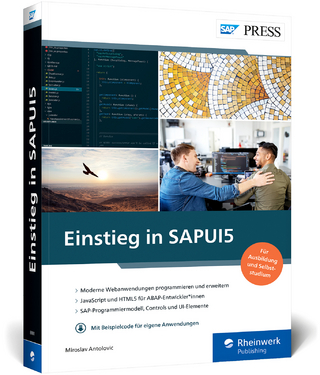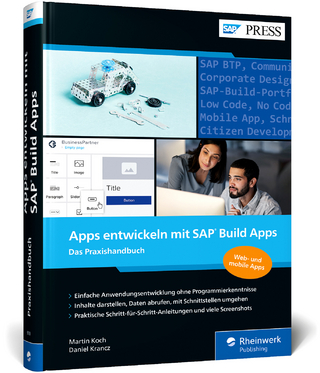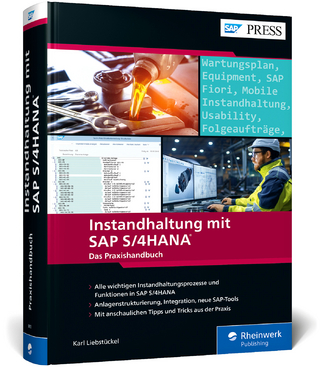
ABAP Develop SAP ERP Financials
SAP Press (Verlag)
978-1-59229-370-4 (ISBN)
- Titel ist leider vergriffen;
keine Neuauflage - Artikel merken
Covers validations and substitutions, user exits, BTEs, BAdIs, and implicit enhancements
Includes discussions on report development, accounting document processing, workflows, and more.
With this book, you learn how to create custom enhancements to standard ABAP code in Financial Accounting for SAP, which will allow you to address all corporate and/or country-specific business rules. The author takes a systematic approach to the topic, introducing general information about the subject of enhancements, and then offering specific coding tutorials consisting of step-by-step instructions and screenshots. Thanks to clear and concise instructions as well as numerous tips and tricks, you'll quickly learn how to find the appropriate enhancement for a particular problem, use all available data, and avoid common programming errors.
Enhancing the Standard System; Learn what functionalities are available for enhancing the standard system, and how to choose the right one.
Corporate and/or Country-Specific Business Rules; Explore the process of creating enhancements that will enable you to adhere to specific corporate and/or country-specific business rules.
Interfacing with Third Parties Understand your options for custom enhancements that relate to exchanging data with external systems (banks, vendors, and customers).
BTEs and BAdIs; Learn how business transaction events and business add-ins can be used to enhance standard Financial Accounting functionality.
Practical, Systematic Approach; Benefit from detailed explanations and a systematic approach that will teach you how to develop custom ABAP programs to modify the SAP standard.
Sergey Korolev is an independent ABAP developer. As a technical consultant, he has participated in numerous SAP ERP implementation projects for various SAP solutions, including SAP ERP Financials (reporting, EDI interfaces, IDoc interfaces, etc.). He is also the author of the SAP Professional Journal article ""Tips and Tricks for Using BAPIs in Accounting Documents"" (February 2010).
Introduction 13
Acknowledgments 15
1 Enhancement Types 17
1.1 Customer Enhancements (CMOD/SMOD) 17
1.1.1 Function Module Exit 18
1.1.2 Menu Exit 19
1.1.3 Customer Exit Subscreen 20
1.1.4 Finding Customer Enhancements 21
1.1.5 Enhancements Summary 23
1.2 Business Transaction Events (BTE) 24
1.2.1 Events and Processes 24
1.2.2 Configuration 25
1.2.3 Finding Business Transaction Events 30
1.2.4 Business Transaction Events Summary 31
1.3 Business Add-In (BAdI) 31
1.3.1 Classic BAdI 32
1.3.2 Kernel-Based BAdI 34
1.3.3 Filtered BAdIs 35
1.3.4 BAdI Subscreen and Function Codes 36
1.3.5 Finding BAdIs 37
1.3.6 BAdI Summary 37
1.4 Implicit Enhancements 38
1.5 Summary 38
2 Master Data Enhancements 39
2.1 General Ledger Accounts 39
2.1.1 Main Transaction Codes for General Ledger Account Master Data 40
2.1.2 Data Enhancement of General Ledger Account Master Data Tables 41
2.1.3 Screen Layout Enhancement 52
2.1.4 Other Enhancements Available in General Ledger Account Master Data 65
2.1.5 General Ledger Summary 67
2.2 Accounts Payable and Accounts Receivable 68
2.2.1 Maintenance Transactions 68
2.2.2 Data Enhancements 68
2.2.3 Screen Layout Enhancements 71
2.3 Accounts Receivable (Customers) 72
2.3.1 Define Your Own Subscreen 72
2.3.2 Define Tabstrip Layout (Customer Screen Group) 74
2.3.3 Activating a Screen Group via a BAdI Implementation 76
2.3.4 Linking Your Own Subscreen 79
2.3.5 Making the Screen Field Transaction Mode Aware and Updatable 81
2.3.6 Calling Moments of BAdI Methods 84
2.3.7 GUI Status Enhancement with Open FI (BTE) 87
2.3.8 Other Open FI (BTE) Events 90
2.3.9 Function Module Exits 91
2.4 Customer Credit Management Data and Screen Enhancement 91
2.4.1 GUI Status Enhancement 92
2.4.2 Data Enhancement 93
2.4.3 Status Screen Enhancement 93
2.4.4 Defining and Activating Partner Products in Transaction FIBF 96
2.4.5 Setting External Partner Functions 97
2.4.6 Further GUI Status Enhancement with Table T061V 99
2.4.7 Additional Credit Management Data User Exits 102
2.5 Accounts Payable (Vendors) 102
2.5.1 Screen and GUI Status Enhancement with Function Group FARI 103
2.5.2 BAdI Definitions 106
2.5.3 Business Transaction Events 109
2.5.4 Function Module Exits 109
2.6 Summary 110
3 Posting to Accounting 111
3.1 The Technical Structure of an Accounting Document 111
3.1.1 The Header 112
3.1.2 Items 113
3.1.3 Parked Document Tables 115
3.1.4 Secondary Indices 116
3.1.5 Total Tables 117
3.2 Core Program Modules of Accounting 121
3.2.1 Screen Enhancement of Accounting Posting Transactions 121
3.2.2 Screen Enhancement of General Ledger Posting Enjoy Transactions with BAdI 127
3.2.3 Screen Enhancement of Customer or Vendor Enjoy Transactions with BAdI 130
3.3 Accounting Document Data Enhancement 135
3.4 Data Processing Enhancements during Dialog Processing 137
3.4.1 Data Processing BTEs 137
3.4.2 BTE Processes 138
3.4.3 BAdI 139
3.4.4 Substitutions and Validations 140
3.5 Data Processing Enhancements during Document Saving 143
3.5.1 BTE Events 144
3.5.2 BTE Processes 145
3.5.3 BAdIs 146
3.6 SAP Internal Techniques for Processing Accounting Data Flow (RWIN) 146
3.6.1 RWIN Summary 148
3.7 Differences in Data Processing between Dialog Transactions and Program Functions 148
3.7.1 Additional BAdI AC_DOCUMENT 149
3.7.2 BTEs That Are Not Called 149
3.7.3 Ending BTE 00001050 (POST DOCUMENT: Accounting Interface) 149
3.8 Summary 149
4 Enhancements in Reports 151
4.1 Technical Architecture of the Line-Item Report 151
4.1.1 Header and Footer Output Enhancement 153
4.1.2 Menu Enhancement with BTE Events 156
4.1.3 Menu Enhancement with BAdI 157
4.1.4 Output Layout Enhancement 161
4.2 New SAP General Ledger Account Line-Item Report Enhancements 163
4.2.1 Header and Footer Output Enhancement 164
4.2.2 Extended Authorization Check 164
4.2.3 Menu Enhancement 164
4.2.4 Enhancing the Output Layout 165
4.3 Summary 166
5 Inbound Scenarios in Financial Accounting 167
5.1 Master Data Migration and Distribution 167
5.1.1 Batch Input 167
5.1.2 HR Master Data 177
5.1.3 ALE/IDoc 178
5.2 Postings Inbound Scenarios 186
5.2.1 Batch-Input or Direct Input 186
5.2.2 Payroll Results 187
5.2.3 Postings via IDoc 188
5.2.4 Electronic Bank Statement 189
5.3 Summary 195
6 Outbound Scenarios in Financial Accounting 197
6.1 Master Data Distribution 197
6.1.1 Batch Input 197
6.1.2 ALE/IDoc tools 198
6.2 Dunning 203
6.2.1 BTEs in Transaction F150 203
6.2.2 BTEs during the Dunning Run 207
6.2.3 Dunning Summary 216
6.3 Payment Program 216
6.3.1 User Exits in Transaction F110 217
6.3.2 User Exits in Payment Program SAPF110S 219
6.4 Summary 224
7 Workflow as a User Exit 227
7.1 Workflow Events: Linking System Actions with External Applications 228
7.1.1 Event Handling 228
7.1.2 Event Creation Options 231
7.1.3 Application Development Implications 231
7.2 Practical Example 232
7.2.1 Prerequisites 232
7.2.2 Workflow-Enabled Class 233
7.2.3 Standard Task 236
7.2.4 Event Creation 240
7.2.5 Now Test! 241
7.3 Summary 243
The Author 245
Index 247
| Reihe/Serie | SAP Press |
|---|---|
| Verlagsort | Maryland |
| Sprache | englisch |
| Themenwelt | Mathematik / Informatik ► Informatik ► Netzwerke |
| Mathematik / Informatik ► Informatik ► Programmiersprachen / -werkzeuge | |
| Informatik ► Weitere Themen ► SAP | |
| ISBN-10 | 1-59229-370-0 / 1592293700 |
| ISBN-13 | 978-1-59229-370-4 / 9781592293704 |
| Zustand | Neuware |
| Haben Sie eine Frage zum Produkt? |
aus dem Bereich


